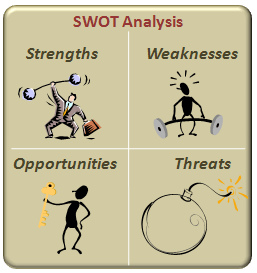Your Company Business Plan - the SWOT Analysis

The First Step in Creating Your Strategic Business Plan
Writing a business plan can sound like an intimidating project, but it's not as difficult as you might think. In my overview to business planning, I mentioned the need for a SWOT analysis and explained how a business plan is structured.
Certainly you shouldn't quit your day job and plunk down your entire retirement without having a good certainty that your new business will succeed. That's a crazy gamble to take! Yet many would-be entrepreneurs do just that. By learning how to create a 25-30 page plan that helps you be prepared for challenges and get ready for success, you can avoid being one of those scary statistics.... You know, the half that fail within five years because they didn't plan for the pitfalls that came their way.
Today, I'll provide a simple explain about what the SWOT analysis is, why you need one, and how to do it.
BENEFICIAL
| HARMFUL
| |
|---|---|---|
INTERNAL TO BUSINESS
| Strengths
| Weaknesses
|
EXTERNAL TO BUSINESS
| Opportunities
| Threats
|
Strengths and weaknesses are about your company and its abilities. Opportunities and threats come from factors your business may not be able to directly control.
SWOT: Strengths, Weaknesses, Opportunities, Threats
SWOT - Strengths, Weakenesses, Opportunities, and Threats. Entrepreneurs who know what they're up against, why they can outperform the competition, which areas they'll need to make stronger, how they can carve out a niche, and make themselves bulletproof will succeed. Without a well-researched SWOT analysis, realistic financial projections, and adequate marketing, even the greatest business in the world is vulnerable to failure.
Let's look at what each of these areas covers:
Strengths
As shown in this table, strengths refers to advantages your company has because of the way you do business or a product lineup that gives you an edge over the competition. For instance, if you're opening a mobile car wash service, one of your business strengths is that you can reach consumers who don't take their in to have it washed because they're too busy.
Weaknesses
In a similar vein, a weakness refers to your company's shortcomings. Perhaps your mobile carwash company has no employees, so you are the only person who can provide the service, leaving hundreds of customers with dirty cars! Perhaps you don't have as much start up capital as similar companies.
Opportunities
Your opportunities highlight ways you can carve out market share. These opportunities are often related to your company's strengths. Using our previous example, the start-up mobile car wash company has an opportunity to establish an entirely new service market within its area because no other companies are offering similar services. Simply stated, opportunities are the ways your company will capitalize on its strengths.
Threats
What can prevent your company from succeeding or force you to revamp considerably? If you've got a mobile carwash operation but banks won't make a loan for you to get the pump truck you envision, you may find yourself unable to thrive as a mobile car wash!
Why You Need a SWOT Analysis (Even When You Know Plenty About Your Business)
A SWOT analysis examines each of the above topics in depth. Small business owners tend to neglect performing a SWOT analysis because they already have extensive expertise in their line of work. "I already know all about the competition! I've been managing this chain of carwashes for a decade!"
Completing a thorough SWOT analysis may be the most time consuming portion of creating a business plan, but without it, entrepreneurs may think their plan is viable only to discover a fundamental error that can hinder them or derail their business completely. Imagine a gung-ho guy who quits his job, buys a pump truck, prints up fliers, and starts introducing his business only to discover his state has passed a law that prevents commercial soaps from being disposed of in parking lots or streets!
Plus, if you need to obtain financing, your lender or investor will want answers. Even if you do know a great deal about your industry, your competition, and how you can succeed, you'll have to demonstrate your credibility on such matters. By having factual data that supports your knowledge, you'll stand a better chance of landing the money you're seeking.
Great Examples of the Why and How
How to Create Your SWOT Analysis
In a word: Research. You'll need to dig up the data to make your SWOT analysis effective:
- Industry Information - Is your industry growing? How much? Why? What trends or societal factors are promoting growth? If the industry is shrinking, why and how much are still important, especially to demonstrate that you have a way to grow despite general industry contraction. Are there niches within your industry that are lucrative and similar to yours? Is the market already dominated by any power players who can pose threats to your fledgling enterprise? Industry data will typically fall under threats and opportunities, and will also be used in the executive summary portion of your business plan. (Even though they're the "O" and "T," the last two segments of the SWOT analysis, I find it useful to start with industry trends and home in on a particular business to avoid unnecessary revisions later on.)
- Local/Market Information - State, city, and county information is vital to your analysis. You'll want to identify who your target market is, how you will reach them, and demonstrate that you have the ability to persuade them to do business with you. Competitors takes into consideration who is performing similar functions for the people that make up your target market. Demographic information describes the number of people in a certain area, age groups, family structures, or even political party. It may refer to your target audience's careers if you're planning to market to 25-40 year old professionals with children who want someone to wash their car while they stay busy at the office. Psychographic information addresses the reasons why your target audience will do business with you, such as how this age group values time with their families. Legal requirements may be relevant if you'll need to obtain permits, if any laws could interfere with opening or operating your business, or communicating with your customers, if you will be paying franchise fees, and more. Your local and market information also falls heavily in the opportunities and threats category of your SWOT report.
- Your Business - Armed with plenty of factual data on the above topics, you're finally ready to address the strengths and weaknesses of your business operations. If you've been thorough, this part will practically write itself. You'll consider the items you've listed under Opportunities and Threats, and use that information to describe the specific reasons those opportunities are best addressed by your new company, and how it'll be able to withstand and protect itself from external threats that exist.
If you've watched the video above, you saw specific examples of many of the kinds of things that can fall into these research categories, and how they were drafted into a sample SWOT analysis that can form the basis of planning a company's success.
Fine Points to Consider for your Business Plan's SWOT Report
Imagine yourself as a lender deciding whether to invest in another person's plan. You'd want to know as much as you possibly could before you offered huge sums to someone who is untested and who you don't know. You'd read the executive summary, glance at the financial projections, and then, if all looked good, you'd dig deeper. You'd pay careful attention to the SWOT analysis and try to find anything that the borrower hadn't considered - any hint of why you shouldn't lend him or her the money.
Before you begin compiling your data, I recommend downloading a few of the free templates to get you started, such as the ones from the Small Business Administration, SCORE, and online sites that have pre-written templates for specific businesses. By reviewing them and customizing them with your own in-depth research, you'll be well on your way to being able to provide the answers that can ensure your business success and boost your chance of appealing to investors.
After you've completed your analysis, try to read it objectively as if you'd forgotten everything you ever knew about your industry and look for those red flags. Although you'll have a categorized report, you can also create a table like the sample above that lists the items in each category or use graphic templates to create eye-pleasing infographics. Ask trusted friends or advisors to do the same for you. One small forgotten item can mean the difference between getting financed and getting a door slammed in your face by people who are very familiar with evaluating business planning and who will recognize it if you've forgotten something.









